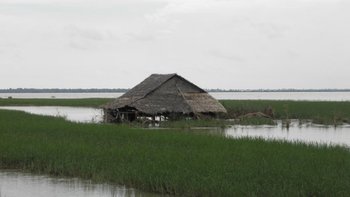People concerned to ensure the new post-2015 development framework helps reduce the impact of disasters on poor people and poverty eradication might have reasons to be cheerful.
The most recent Open Working Group 11 (OWG11) on the SDGs saw a significant increase in the states actively pushing for a disaster target under a poverty eradication goal, and for disaster-related targets and indicators to be incorporated into other goals on water and urban settlements.
As this process of Open Working Group discussions moves into the final months, the importance of state support for an effective, clear and ambitious disaster target/s and indicators cannot be underestimated.
If you haven’t been following the post-2015 development discussions closely you may think it seems a well-recognised fact: Disasters have a devastating impact on development. Families lose homes, livelihoods and loved ones, communities lose businesses, jobs and services, children and particularly girls miss school and are at risk of early marriage – the list of impacts goes on.
According to the United Nations, over the past twenty years disasters from natural hazards have affected 4.4 billion people, claimed 1.3 million lives and caused $2 trillion in economic losses. For the first time, disaster losses globally have topped $100bn for three consecutive years (2010–2012), far outstripping humanitarian aid.
So for those of us working in the humanitarian and disaster prevention sector it has seemed logical and essential that the new post MDG framework being discussed at the UN in New York include specific commitments to reducing the impact of disasters on poor people and poverty eradication efforts. Indeed this was a recommendation of the High Level Panel on the post-2015 development process published in 2013.
However, nothing is straightforward when states negotiate a set of global goals and targets to coordinate billions in aid and development finance. Getting some agreement from states that a disaster target does need to be included in the framework continues to be a fragile and hard fought issue.
Efforts by a core group of states, NGOs, academics and UN agencies has been instrumental in keeping up pressure for a disaster target at negotiations of the Open Working Group on SDGs.

Photo credit: Flickr/ EC DG Echo
An expert workshop in March hosted by Kings College London, Christian Aid and Oxfam brought disaster specialists together to drill down into methodologies of measuring targets and indicators, to answer a core question from states: What kind of target and indicators on disasters would be feasible? And to paraphrase Einstein ‘we need to count what counts, and not what is easily counted.’
This workshop looked at the question of what criteria could be used to determine what a ‘good’ disaster target or targets would look like; and experts then reviewed six different methodologies for formulating disaster targets and indicators against agreed criteria:
- Reducing economic, physical and social losses;
- Reducing vulnerability and risk (measured through existing indices);
- Preventing impoverishment;
- Building community resilience;
- Reducing risk (measured through modelling);
- Attitudes and perceptions of risk (measured through polls).
The debates that took place and the recommendations that were ultimately made can be found in the attached summary; with the specific recommendation for a disaster target under the poverty goal outlined as follows:
Target: Reduce by X the impact of disasters on poverty eradication and economic growth, including the impact on poor men and women.
Indicators:
- Direct economic losses from disasters, as percentage of GDP
- Loss of household assets from disasters, as percentage of household income
- Number of people killed and directly affected by disasters, women and men, and ratio
- Number of people pushed into poverty as a result of disasters, women and men, and ratio
What is crucial now is that enough states get behind such a target and the wider recommendations for integrating risk management across the framework, to make sure it is included. So far the humanitarian community has been very absent from discussions.
Perhaps now it is time to ensure those people who see the impact of disaster first-hand also push for the targets and indicators they know will make a difference to preventing disasters.